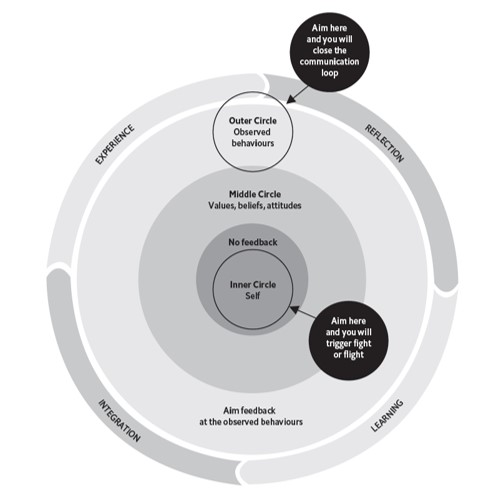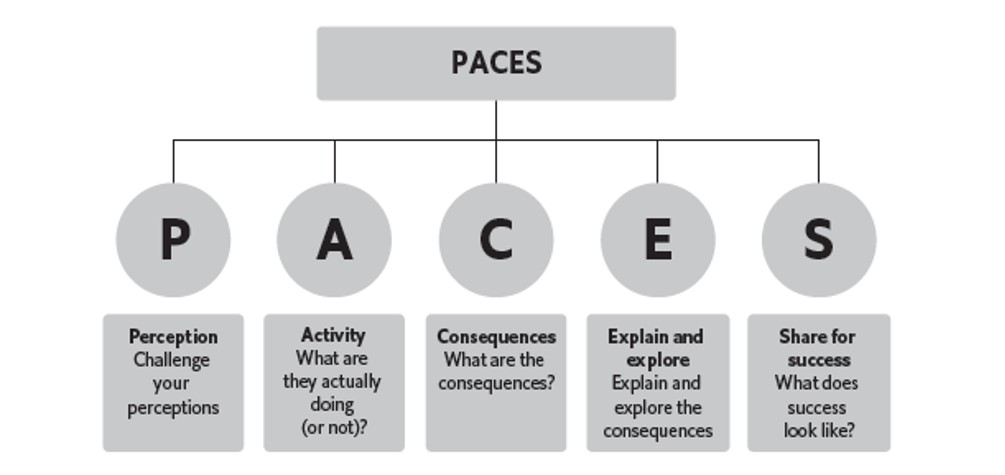Giving and receiving feedback should be straightforward. But stress and anxiety make it more complicated than that. We need feedback to learn and grow, but we also have a deep human need to be loved and accepted the way we are. To address this difficulty, Margaret Cheng created a framework to improve how we give feedback, by focusing on people’s observed behaviours, not their values, beliefs and attitudes.
Launching a book has made me think (again) about feedback and the role it plays in learning. I had thought the difficult bit was writing the book. It turns out there are still a lot of new skills to learn, as I progress from HR consultant to published author. Of course, giving feedback to an author who has written a book about giving feedback is a very meta experience. The publishing team are aware of this and so tried extremely hard to smooth my path. But I haven’t always had lovely people falling over themselves to offer supportive and helpful feedback when I’ve been learning in a new role. It seems that I am not alone.
As part of the research for the book, I ran a poll, asking people their most likely response when they hear the question, “Can I give you some feedback?” Responses ranged from: “Must you? It makes me anxious,” to “I know it’s good for me, but I’d rather not,” to “I would prefer to have a root canal, without anaesthetic.” I here explore the reasons behind these responses and suggest a couple of methods you can use to transform unhelpful feedback, into a learning experience.
What is feedback?
First of all, let’s just clarify what “feedback” is. If you look through a dictionary you will find several definitions. Some are more helpful than others. I find the most useful to be the following definition taken from Google’s English dictionary (provided by Oxford Languages):
feedback noun (opinion) Information about reactions to a product, a person’s performance of a task, etc. which is used as a basis for improvement.
The important words here are opinion, Information and reactions. Giving feedback is a basic human skill, based on the ability to communicate. When you give feedback, you are simply communicating information, your opinion about and reactions to something someone has done. As humans, we are social creatures. We are always communicating, whether we do it consciously or not. So, giving and receiving feedback is something everyone does all the time, whether they are aware of it or not.
A key message to remember when giving and receiving feedback is this: feedback is always about communication. In a simple communication loop, it’s the thing that closes that loop so that you know your message has been received and (hopefully) understood. At work, it provides a crucial tool for helping people understand their impact and supporting their development.
The paradox of feedback and humanity
In theory, giving and receiving feedback should be a straightforward, natural part of our day. However, this is not always the case. All the responses above feature a clear acknowledgement of the stress and anxiety involved. This anxiety demonstrates a paradox: you need feedback from people around you, to help you learn, but at the same time, you have a deep human need to be loved and accepted just the way you are, even on a bad day, warts and all.
So, when you arrive at work, someone asking “Can I give you some feedback?” produces a human reaction (or stress response) caused by our biological evolution. It has pretty much the same effect on your brain as spotting a dark shadow appearing round a corner or hearing stealthy footsteps behind you at night.
Feedback and learning
Unfortunately, it is impossible to see yourself in action. You may be extremely clear about how you intend a particular comment to come across, what you mean to achieve or what you hope might be the result of your actions. However, whatever your intentions are, you are reliant on other people for feedback on how it lands with them. Without feedback, you won’t know how you come across to other people and will not have a complete understanding of the impact of your behaviour.
Feedback takes you away from your inner view of yourself and forces you to realise that other people see you differently. This is a big ask (both for you and for them.) You will be particularly vulnerable to a stress response when you are learning something new, and your sense of self feels more exposed.
To explore this further, you could look at neuroscience. You could also focus on the cumulative effect of poorly given feedback and links with clumsy corporate processes. For example, you may sit down for your annual appraisal and get some amalgamated corporate feedback like: “I’ve asked around, Gerry, and everybody in the office thinks you are not a team player.”
Leaving aside the natural stress reactions to this comment, you won’t always recognise the self that is reflected back to you via feedback. It may not be a self you want to welcome into your world view. Even if everyone in the team agrees that this is the accepted wisdom in the office about who you are and how you operate.
You are, of course, always free to decide just to take yourself (and your lack of being a team player) elsewhere, where your many other positive traits are appreciated. Their loss, not mine, you might think, a shade bitterly. However, you might also lose something by rejecting this (admittedly) clumsy, unfair feedback outright. Even badly presented feedback about the way you are perceived may be useful.
Take control
Sometimes feedback that you believe is wrong, really is wrong. But sometimes it can help you uncover important information about yourself. Take control, use my giving good feedback framework. In it, I make the link between David Kolb’s experiential learning theory and giving good feedback. The focus is on observed behaviours and the aim is to help people work round the four stages of Kolb’s learning circle.
Figure 1. The ‘giving good feedback’ framework

Good feedback focuses on the behaviours people can see and change (the outer circle) rather than challenging their values, beliefs and attitudes (the middle circle) or commenting on people’s personality and self-esteem (the inner circle).
So, good feedback:
- Avoids judgement and generalisation.
- Focuses on observed behaviours.
- Creates a climate for learning, rather than fight-or-flight.
As a result, it avoids the classic feedback problem of triggering a defensive reaction. Instead, it helps people to move round the circle via the key steps of experience, reflection, learning and integration, thus supporting progress and learning.
When you receive feedback that you think is wrong, or a comment that feels as though it is attacking your sense of self, take the sting out of the discussion by referring it back to observed behaviours. Gerry, for example, could ask: “What behaviours have you observed that make you think I am not a team player?” Sometimes people struggle with the answer. Feedback is all about communication and discussion. You can move the discussion on by using my PACES model, inspired by the old British film, Chariots of Fire. In the film, Harold Abrahams has just lost a race. His girlfriend tries to encourage him. “Cheer up Harold, the other chap was just faster,” she says (or words to that effect.)
Unsurprisingly, Harold ignores her. He wants to win, not cheer up. Fortunately, Sam Mussabini pops up. “I can find you an extra thirty seconds, Mr Abrahams,” he says. How does Sam do that? Does he stand next to Harold, with a megaphone, shouting: “Just run faster!” Of course not, even though the equivalent happens in businesses across the land every day: “Start being a team player, now, Gerry!” If Harold could run faster or Gerry could start being a team player, whatever that means, then that is just what they would do, isn’t it? What Sam does is coach Harold through films of his performance and compares them to films of runners who win their races. This shows him some techniques (or behaviours) he could learn to use at different points in the race to improve his performance. Harold tries some behaviours out, practises them, and finally finds his thirty seconds. This is all he needs to win.
You can do the same at work. Make your feedback givers put their feedback through PACES. This model is designed to provide a useful structure for questions and discussion. The result is the nearest thing possible to someone following you round with a film camera at work. It is always up to you. Feedback is not a universal truth that you are obliged to accept. It is simply someone attempting to communicate information about their reaction to something you have done, and its impact on them. Try these models out. And you may be surprised by what you learn about the impact of your behaviour on other people.
Figure 2. PACES model

- This blog post is based on “Giving Good Feedback“, Economist Books.
- The post represents the views of its authors, not the position of LSE Business Review or the London School of Economics.
- Featured image provided by Shutterstock
- When you leave a comment, you’re agreeing to our Comment Policy.






Makes a lot of sense